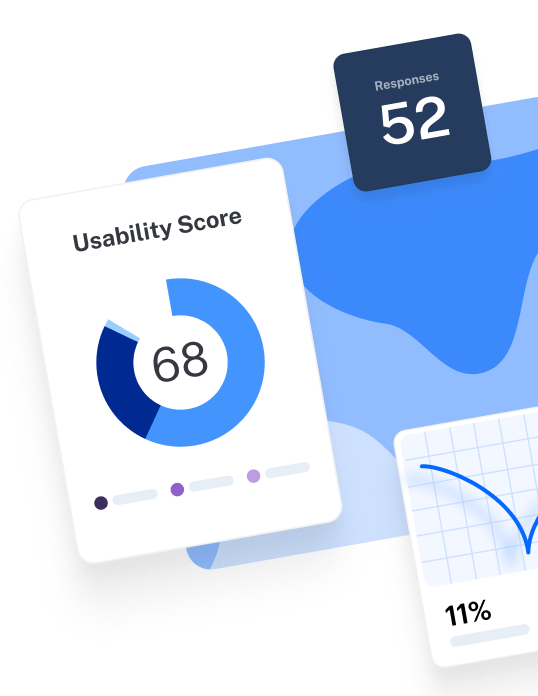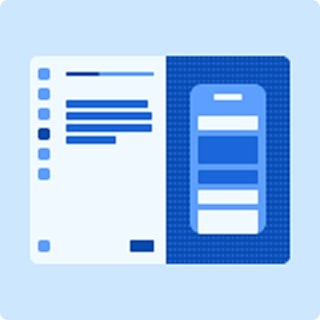
Content Testing for UX: From Copy to Conversion
Content testing helps measure the quality and performance of your content, to guarantee bad content never goes live. This complete guide breaks down essential content testing methods, tools, and key steps for refining and evaluating UX content.
Eliminate ineffective content, invest in success
Maze offers a comprehensive suite of content testing tools to evaluate content and UX, delivering actionable insights into the effectiveness of content

Chapter 1
Content testing like a pro: Strategy, techniques, and examples
Unsure if your content is readable, effective, and engaging? Understand the what, why, and when of content testing in this guide.
Content is fundamental to every aspect of your digital experience. From landing page copy to your in-app instructions, it’s one of the main ways users interact with, understand, and experience your product.
So if your content misses the mark, your user satisfaction metrics will show it.
Content testing is the way to ensure any content across your product, app, or website meets user needs, is clear and readable, and actually resonates with users.
To kick off this guide, we’ll cover when and why to conduct content testing, six ways to evaluate content, and finish up with an example of content testing. Read on…
What is content testing?
Content testing is a UX research method that measures the quality and performance of your content. With content testing, you can check if the content you create resonates with users, speaks directly to their pain points, and provides enough context to help them navigate your product and complete tasks successfully.
Ultimately, it ensures your content quality meets your target audience’s needs and expectations. You can conduct content testing at any stage of product development to test product, app, or website content.
💡 FYI
Content doesn’t just refer to text that appears on your digital product. It can mean video, images, layout, and more.
What content testing methods are there?
There are plenty of ways to gauge how effectively your content engages and guides your users, including:
- Task-based usability testing: Evaluate if participants can use content to navigate a digital experience effectively by monitoring participants engaging with your product’s content and using it to complete specific tasks
- Five-second tests: Participants get five seconds to read through your content before answering questions about the content’s main message to see what they understand or what stands out
- A/B testing: Unsure which version of your content hits home with users? A/B testing lets you create two versions, divide them between your audience, and track which version performs better
- Card sorting: Test how you should group your content according to user’s mental models by asking users to categorize content into groups that are logical to them
- Cloze tests: Take sample text from your content, create gaps, and ask participants to fill in the missing words—this gauges how understandable your content is for your target audience
- Highlighting tests: Get direct customer feedback on content by asking participants to directly highlight parts of your content that they deem to be helpful or confusing
Want to learn more about these content testing methods? We cover each of these research methods in depth in our chapter on Content Testing Methods. Skip ahead if you’re ready to get started, or stay tuned for more on the value of content testing and how it fits into the research and development process.
What are the benefits of content testing in UX?
Content testing is a preemptive tool to prevent bad content from finding its way into your product, app, or webpage. Bad content can completely disrupt the user experience—leaving them confused, unengaged, or potentially driven away from using your product altogether.
Content testing helps you:
- Identify what content works, what doesn’t, and why: Collecting feedback from users helps determine which elements of your content drive engagement and what causes users to leave, ultimately helping you refine your content strategy and boost customer retention.
- Create accessible products and experiences: Testing content against accessibility guidelines ensures content is easy to read and navigate for all users, including those with disabilities.
- Build an intuitive user experience (UX) for your audience: Content testing uncovers areas where users have trouble navigating your product. Pinpointing these sections lets you make necessary adjustments for flow and clarity, ultimately providing users with a more intuitive experience.
- Choose effective keywords and language: Content testing methods like A/B testing let you experiment with keywords and choose the right option for your digital experience to rank high on search engines.
- Improve your content development strategy: The results from content testing give you insights to develop and refine your long-term content strategy. With feedback, you can make data-driven decisions to create content that’s aligned with your target audience’s needs and expectations.
- Prevent users from becoming confused or disrupted: Testing the clarity and coherence of your content is key to ensuring users don’t get lost and frustrated while interacting with your product or digital experience.
Put simply, content testing helps ensure that good content makes it into the product and that bad content never leaves the testing process.
6 Ways to evaluate content + questions to ask
So, what does content testing look for? What are the different parts of content to review?
There are six main ways to evaluate content, each examining a key area of in-product content. During content testing, you can assess these areas by asking the right research questions to your participants.
We spoke to Kate Varga, Senior UX/UI Designer at Creative Navy, for the types of questions she asks when reviewing these content parameters. But before diving into content testing, Kate reminds researchers to look out for cognitive biases:
“When asking direct questions, users may feel inclined to respond favorably toward the product because they feel like they themselves are being tested. The more abstract goal of improving the product seems to fall off their radar.
“To counter this, we avoid simple yes-or-no questions, opting for rating scales instead. Scales provide nuance and reflect the acknowledgement that a product is multi-layered, neither entirely good or bad. Crafting questions that are specific and flexible is essential for capturing these subtleties and gathering meaningful feedback.”
✨ Learn more
Check out our guide to writing bias-free research questions for more expert advice
1. Usability
Usability testing is about reviewing how intuitive your content is to engage with. Your aim is to ensure your target audience can effortlessly use your content to complete tasks without unnecessary friction. Assessing content usability contributes to a seamless user experience for your user and helps them smoothly move through the user journey.
Content testing for usability: Example questions
- How intuitive did the product feel to you? Scale: 1 (Not intuitive at all) to 5 (Very intuitive)
- How easily were you able to accomplish the task you set out to do? Scale: 1 (Very difficult) to 5 (Very easy)
- How efficient did you find the product in helping you complete your goals? Scale: 1 (Not efficient at all) to 5 (Very efficient)
2. Readability
55% of users view pages for less than 15 seconds. That’s not a lot of time to get users hooked, reading, and interacting with your digital experience. To ensure they engage, you need to make your content easy to understand.
Users should be able to scan your content once, understand it, and know what further steps to take. The quicker users can absorb information, the better they can grasp key messages, realize your product’s value, and sign up to use it.
Content testing for readability: Example questions
- How helpful were headings, bullet points, or lists in guiding you through the content? Scale: 1 (Not helpful at all) to 5 (Very helpful)
- How likely are you to read this type of content all the way through? Scale: 1 (Very unlikely) to 5 (Very likely)
- How well did the content match your reading level or expectations? Scale: 1 (Not well at all) to 5 (Very well)
3. Accessibility
Accessibility refers to your product’s ability to provide a great experience to all users—regardless of how they’re consuming your content. Consider how screen readers and other accessibility aids will interact with your content. Not only does this widen your audience, but it creates an inclusive design that everyone can use.
Digital products should follow the Web Content Accessibility Guidelines (WCAG). Aligning your content with this comprehensive framework ensures your product is accessible across a wide range of devices for people with disabilities.
Content testing for accessibility: Example questions
- How clear and legible did you find the font style and size? Scale: 1 (Very unclear/illegible) to 5 (Very clear/legible)
- Did the use of color in the text (e.g., links, headings) make it easier or harder to read? Scale: 1 (Very difficult) to 5 (Very easy)
- Were there any parts of the text that you found hard to read because of the font or contrast? Scale: (Not hard at all) to 5 (Very difficult)
4. Searchability
Searchability refers to how easy it is for users to find your digital experience online. Testing for searchability ensures your website is visible and discoverable. By testing and optimizing your content for SEO (search engine optimization), you can drive more traffic towards your content, engage your target audience, and ultimately convert them into paying customers. Besides increasing your organic traffic, testing and ranking high for keywords can boost your brand’s perceived authority.
Content testing for searchability: Example questions
- How easy was it to find the specific information you were looking for? Scale: 1 (Very difficult) to 5 (Very easy)
- How quickly were you able to locate relevant information using the search function? Scale: 1 (Very slow) to 5 (Very quick)
- How accurate were the search results in helping you find what you were looking for? Scale: 1 (Not accurate at all) to 5 (Very accurate)
5. Tone of voice
If your brand could talk, what would it sound like? Consider the tone and voice of your content. Not only does this shape your brand’s identity, but it's also a major tool for resonating with your target audience and users. While voice refers to your brand’s overall personality, tone refers to the attitude you convey in your content—which can differ depending on the content and intentions.
When testing content’s tone and voice, ensure both elements are clear, recognizable, and engage with users on a personal level.
Content testing for tone of voice: Example questions
- How clear and professional did the tone of the content feel to you? Scale: 1 (Not clear or professional at all) to 5 (Very clear and professional)”
- How engaging did you find the content? Scale: 1 (Not engaging at all) to 5 (Very engaging)”
- How well did the tone help you feel comfortable or at ease while using the product or reading the content? Scale: 1 (Not at all) to 5 (Very well)
6. Navigability
Users should be able to seamlessly move through your content to get the information they came for. While research methods like tree testing are ideal for testing navigability, content testing is an additional way to ensure users can effortlessly interact with your product, complete tasks, and access your features without a hassle.
When testing your content, look for any friction points that signify confusion, overwhelm, and frustration. Users should be able to browse through your content and use navigation elements to progress through the user journey.
Content testing for navigability: Example questions
- How easy was it to navigate through the product to find what you needed? Scale: 1 (Very difficult) to 5 (Very easy)
- How well did the layout and graphical user interface help you find what you were looking for? Scale: 1 (Not helpful at all) to 5 (Very helpful)
- How clear was the organization of the content or features in helping you complete your task?
Considering these six areas when testing your content will help ensure it’s exactly what your audience wants and needs.
Wherever there is content in your product, it’s worth doing content testing. We’re yet to see a product that uses no content at all (as unique as that would be).
Think about every piece of content on your product—your homepage, error messages, menu buttons, filters, product pages, and more. At first glance, you may not think of this as content, but it is—and it all needs testing.
To decide which content to test, prioritize based on the urgency and importance the task holds for users. If it’s a critical message, such as an error message in payment flows, then it’s vital that users easily understand the content to achieve their goals.
Vaida Pakulyte, UX Lead at Technigo, emphasizes that when planning to test content, “it’s important to give a reference for users to evaluate the content.” For example, you can provide context, such as a design mockup or a prototype.
Include visual elements, buttons, and everything else that will be on the final design. Your users will be seeing your content in context, so the way you test it should be the same (whenever possible).
When should you conduct content testing?
Determining the right stage of development to test your content is tricky. On the one hand, you want your content to reflect the real content your users will encounter. On the other, you don’t want to spend lots of time creating fully-formed and finalized content only to discover it’s not what your users need.
Ultimately, like most types of research and user testing, content testing works best when used iteratively at multiple stages in the design process.
- During the conceptualization phase: Use content testing to understand the broad framework of content you’ll need (what information users need, the language they use, etc.) and get an overview of the conversation you want to have with users
- Midway through design: Run content tests to validate your current content and understand where you may want to change direction, before you invest too much time in the wrong area
- Close to and after launch: Check if iterated content is clear to all potential users and achieves what you set out to do—how does it make users feel after they read it? Does it work with accompanying design or imagery?
Let’s take a look at an example.
What does content testing look like: An A/B example
Let’s say you’ve built a project management SaaS tool for remote teams called TaskTrailer.
You’re unsure how to present instructions for new users on how to create their own projects—should you go in-depth with detailed, long-form text explaining each step? Or should you go for quickfire bullet points to keep it concise?
To decide, you use Maze, a content testing tool which offers A/B content testing to identify the best option.
After recruiting 50 users through Maze Panel, you give half of them version A, and the other half version B. You instruct users to complete the task of creating a project by reading the instructions before them.
Users interacting with version A felt the content was thorough but were overwhelmed by the amount of text. They also had to reread it several times due to unclear instructions. It gets a completion rate of 55%.
Users interacting with content version B, on the other hand, had little to no complaints, and a task completion rate of over 90%.
Based on the results of this test, your team settled on version B with some slight enhancements. You’re definitely keeping the bullet points for readability, and you’ve provided just enough information for users to breeze through your digital product without getting confused: it’s the best of both worlds.
Next up: How to conduct content testing
Evaluating content is a key part of user research. It helps you understand if your content is clear, and concise, and if it resonates with your target audience.
By getting feedback, you can make data-backed decisions and ensure content provides a seamless experience that drives engagement, makes processes more intuitive, and even gets you new users.
Next, head to chapter two for steps to performing content testing.
Eliminate ineffective content, invest in success
Maze offers a comprehensive suite of content testing tools to evaluate content and UX, delivering actionable insights into the effectiveness of content

Frequently asked questions about content testing
What is a content-based test?
What is a content-based test?
A content-based test is a user testing type designed for evaluating the effectiveness, clarity, and performance of your visual and written content. It helps you understand how well your content meets user needs, resonates with your audience, and drives your desired outcomes.
How to conduct content testing?
How to conduct content testing?
Conducting content testing is a process of six steps:
- Identify your goals
- Choose your content testing method
- Test your content test
- Gather test participants
- Conduct the test
- Analyze results


